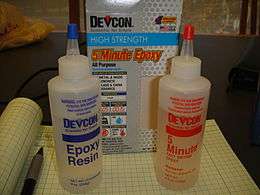Epoxy glazing
Ceramic fixtures are being more commonly glazed with 2 part epoxy compounds. The first component is a clear or opaque resin combined with a catalyst or hardener. The proper procedure requires that the nonporous fixture be sand blasted to create a rough surface for the epoxy primer to adhere to. Once the primer has dried the topcoat is applied. Since a true epoxy begins to yellow at the age of 1 year acrylic polyurethane compound is used in the topcoat. This resin is also catalyzed with a hardener and can last up to 15 years or more with proper maintenance.
Formica countertops can also be glazed in this fashion using a faux stone or granite look.

The blue one is Epoxy Resin, the red one is Epoxy Hardener.
References
This article is issued from Wikipedia. The text is licensed under Creative Commons - Attribution - Sharealike. Additional terms may apply for the media files.